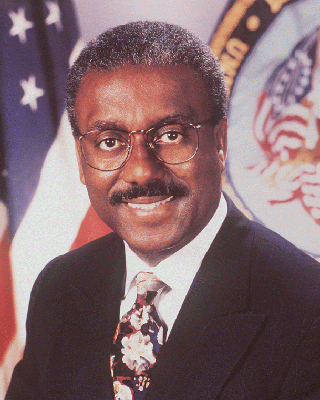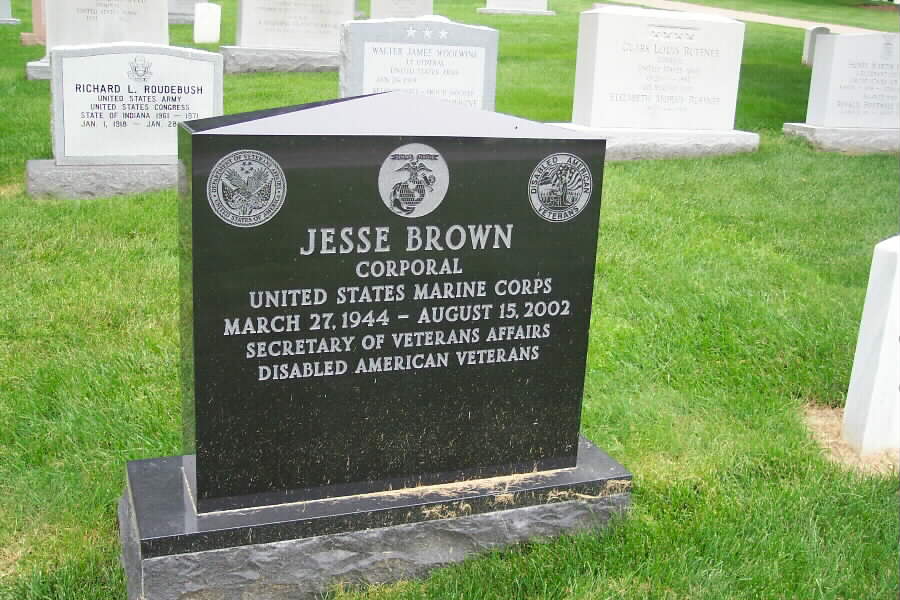The Honorable Jesse Brown died at the age of 58 in his Warrenton, Virginia, home on August 15, 2002. This decorated and disabled Vietnam veteran was diagnosed several years ago with lower motor neuron syndrome, which is similar to amyotrophic lateral sclerosis (ALS) or Lou Gehrig’s disease. Jesse Brown is survived by his wife Sylvia, mother Lucille, sister Dorothy, grown children Carmen and Scott, and granddaughter.
Jesse Brown was my friend in the truest sense of the word. He was also a friend and staunch advocate for all veterans, taking an active interest in their rehabilitation, especially those wounded in combat. For over 30 years, he worked tirelessly on behalf of veterans through his career at the Disabled American Veterans (DAV), which culminated in his tenure as Executive Director from 1989 to 1993 and then as Secretary of the Department of Veterans Affairs (VA) from 1993 to 1997. His tenacity made him a driving force in improving the circumstances for generations of veterans and caused the Wall Street Journal to feature him on its front page under the banner “You Don’t Mess with Jess’.”
Jesse Brown
Secretary of the Department of Veterans Affairs 1993-1997
In 1963, Jesse enlisted in the Marine Corps. While stationed in Vietnam in 1965, he suffered severe combat wounds on patrol in Da Nang. His shattered right arm remained partially paralyzed, despite a long and arduous process of rehabilitation in military and VA hospitals. While Jessie was recovering at the Great Lakes Naval Hospital near Chicago, a DAV National Service Officer assisted him in obtaining VA benefits. Soon after, in 1967, Jesse embarked on a career with DAV. As DAV’s Executive Director, Jesse tirelessly lobbied for veteran’s benefits and programs before Congress, the White House, and federal bureaucracy. His unflinching courage in pushing for congressional legislation firmly established his reputation as a distinguished proponent of the health and welfare issues of disabled veterans and their families. His passion for the job was even recognized by Al Gore, who was soon to be the Vice President of the United States and complimented Jesse’s oratorical expertise at a national DAV convention. Soon thereafter, in January 1993, then President Clinton called upon Jesse to be Secretary of Veterans Affairs, directing the second largest Cabinet agency in the federal government. I was very honored when Jesse asked me to be his Chief of Staff and Counsel, and I came out of retirement to serve him and the nation’s veterans.
Jesse took an active interest in rehabilitation of all veterans, especially the combat wounded. His consistent efforts to improve health care delivery and expand benefits for veterans included increasing VA research for veterans suffering from agent orange, radiation, and mustard gas exposure. Jesse also augmented support for sufferers of posttraumatic stress disorder (PTSD). He set the precedence for national research that labored to identify the causes of various Persian Gulf war-related ailments. Under Jesse’s leadership, grants were approved for the expansion of homeless veterans programs. Medical services and rehabilitation were offered to improve the condition of disadvantaged, at-risk, and homeless veterans with psychiatric and physical disorders, in addition to drug abuse. These special programs made veterans’ lives more self-sufficient by offering transitional shelter, permanent housing, and employment, in what became the VA’s Compensated Work Therapy/Transitional Residence (CWT/TR) Program. Jesse also convened the first national summit meeting on homeless veterans. Initiatives also were implemented for women veterans, to include counseling for sexual trauma experienced while serving on active duty. New women’s clinics offered specialized exams, health education, and support groups, providing women with the opportunities to make beneficial changes in their lives.
Jesse decentralized management and health care provisions by expanding satellite outpatient clinics in regions far from large VA hospitals. Better access to treatment made it less costly and time-consuming for low-income veterans, some of whom lived in rural areas without reliable transportation. Jesse’s emphasis on primary care fostered a more positive attitude from veterans toward the VA. His managerial talent instilled a new pride among VA employees as well, and his promotion of “PUTTING VETERANS FIRST” still resonates within the agency.
This is just the “tip of the iceberg” when it comes to Jesse’s accomplishments and contributions. On Jesse’s retirement from the Department of Veterans Affairs, the DAV noted that he was “the most effective veteran’s advocate in recent memory.” This compassionate, driven, and intelligent man will be greatly missed by many. The developments directed by his remarkable leadership and advocacy for over 30 years have benefited all Americans, not just veterans. Jesse once said to me that “life is hard by the yard but a cinch by the inch,” and he certainly made every inch count in his too-shortened life.
Jesse Brown was sworn in by President Clinton as the Secretary of Veterans Affairs on January 22, 1993. Secretary Brown directs the federal government’s second largest department, responsible for a nationwide system of health-care services, benefits programs and national cemeteries for America’s 26.5 million veterans.
Under Secretary Brown’s leadership, VA has expanded benefits for veterans who were prisoners of war or were exposed to Agent Orange, radiation or mustard gas, and has expanded treatment services to those suffering post-traumatic stress disorder. Mr. Brown also directed that VA undertake an aggressive research initiative to determine the causes of the illnesses of Persian Gulf War veterans. He successfully worked for the enactment of laws authorizing VA to pay compensation for these veterans’ undiagnosed illnesses and to provide them with priority health care for illnesses they possibly incurred in the Gulf. To reduce a backlog of veterans benefits claims, the Secretary formed a task force whose recommended changes have led to improved technology, redesigned work processes and more staff training.
Mr. Brown convened the first national summit meeting on homeless veterans. Under his leadership, VA began awarding grants to groups that aid the homeless and added homeless programs at medical centers. Expanded services to women veterans include counseling for sexual trauma suffered in the military, new health centers with specialized treatment capabilities, and more full-time coordinators for women’s care at VA medical centers. Mr. Brown ordered sensitivity training for all VA employees as part of his campaign of “Putting Veterans First.” He guided VA’s role in the administration’s health-care reform initiative and continues to press for changes to make the VA medical system competitive in a changing health-care environment. His priorities are to maintain the VA system as an independent provider, to broaden veterans’ access to the system and to offer a continuum of comprehensive care.
Mr. Brown enlisted in the Marine Corps in 1963 and was wounded during combat in 1965 while patrolling in the Danang area of Vietnam. Before coming to VA, he spent his professional career with the Disabled American Veterans, serving as its executive director from 1989 to 1993. In that position he directed the DAV’s Washington office, supervising its national service, legislative, employment and volunteer programs, which included leading the organization’s advocacy efforts with Congress and the Executive Branch on behalf of disabled veterans and their families.
Born on March 27, 1944, in Detroit, Mr. Brown spent his teen and early adult years in Chicago. An honors graduate of Chicago City College, he also attended Roosevelt University in Chicago and Catholic University in Washington, D.C. He is a member of The American Legion, AMVETS, Disabled American Veterans, Veterans of Foreign Wars, Vietnam Veterans of America, Marine Corps League, Military Order of the Purple Heart, Polish Legion of American Veterans, USA, Jewish War Veterans and The Retired Enlisted Association.
During five years as Secretary of Veterans Affairs in the Cabinet of President Bill Clinton, the late Jesse Brown earned the love and respect of his fellow veterans across the United States. This well-deserved esteem made Mr. Brown uniquely qualified for his role as the first Executive Director of the Disabled Veterans’ LIFE Memorial Foundation.
While heading the second largest department in the federal government, Mr. Brown worked day and night to improve the VA’s delivery of health care and benefits to those who served in our nation’s armed forces. In this position, he gained extensive background in business, healthcare and technology. With nearly a quarter million employees working at more than 1,000 facilities across America, the U.S. Department of Veterans Affairs (VA) had an annual budget of $40 billion during Mr. Brown’s tenure. His great source of pride, however, was his drive to make the VA a customer-oriented enterprise that “puts veterans first.” Those familiar with the VA’s history will understand the magnitude of this achievement.
In naming Mr. Brown to his Cabinet, President Clinton chose the Executive Director of one of the nation’s largest, most successful charities – the million-member Disabled American Veterans. Mr. Brown devoted a quarter of a century of his life to serving his fellow veterans as a National Service Officer with the DAV, rising rapidly through the organization’s ranks. With an annual budget exceeding $100 million, the DAV offers crucial services from 70 offices across the United States. As Executive Director at the DAV’s National Service and Legislative Headquarters in Washington, Mr. Brown became prominent in the policy-making circles of our nation’s capital. His lobbying on behalf of America’s veterans before Congress, the White House and the federal bureaucracy earned him a reputation as a remarkably effective advocate.
Mr. Brown joined the DAV’s professional staff after a lengthy recuperation from wounds suffered in combat while serving as a U.S. Marine in Vietnam. During his 25 years with the DAV, he established an unchallenged reputation as the nation’s foremost expert on veterans’ benefits and programs.
Following his years in the President’s Cabinet, Mr. Brown moved vigorously into the business world. He formed Brown and Associates, a world wide consulting firm. His expertise figured prominently in planning and marketing initiatives at a broad variety of companies domestically and internationally.
An honors graduate of Chicago City College, Mr. Brown also studied at Roosevelt University in Chicago and Catholic University in Washington, D.C. He also joined noted philanthropist Mrs. Lois Pope and the DAV’s Art Wilson in their drive for build a memorial honoring disabled veterans. Up to his death in the summer of 2002, Jesse remained highly engaged in this initiative, even as Lou Gehrig’s Disease robbed him of his ability to move and, toward the end, to communicate.
Mr. Brown’s determined spirit remains with the Disabled Veterans LIFE Memorial Foundation. No one could ever extinguish a flame so bright!
Jesse Brown was buried in Section 30 of Arlington National Cemetery.
Michael Robert Patterson was born in Arlington and is the son of a former officer of the US Army. So it was no wonder that sooner or later his interests drew him to American history and especially to American military history. Many of his articles can be found on renowned portals like the New York Times, Washingtonpost or Wikipedia.
Reviewed by: Michael Howard


